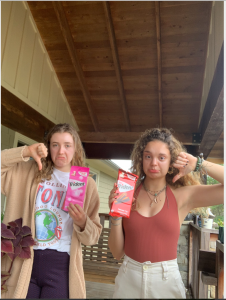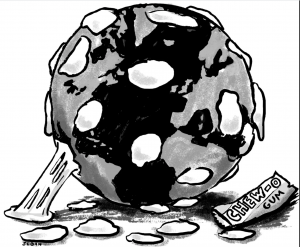By Calla Pederson
If you know me, you know that I’m always found with a mouth full of gum – it’s basically a personality trait at this point, an extension of myself. I feel incredibly lucky that my environmental-scientist parents instilled pretty sustainable habits within me, so when I decided to go landfill-waste-free for a few days, the only thing I really had to cut out was my gum-chomping habit. Recently, I saw a video on TikTok (by @chessi) about gum’s adverse environmental and health effects, which I had never considered and inspired me to look further into this routine of mine.

Chewing gum is the second most littered item on Earth, second only to cigarette butts! Chewing gum has long been a practice of humans, but Indigenous peoples chewed tree resin. The first manufactured gum was chicle-based. Chicle is tree sap from the Sapodilla tree.

Later, after gaining widespread popularity in the United States, the synthetic polymer polyisobutene replaced the more sustainable option. Other “gum bases” (aka plastics) include petroleum, polyethylene, butylated hydroxytoluene (BHT), or polyvinyl acetate and are linked to cancer and autoimmune disorders. It was found that high doses of the preservative BHT in animals causes cancer, but the FDA considers minimal doses safe. Titanium dioxide is used to whiten and smooth products, and in high doses, caused organ and nervous system damage in rats. Goodyear, yes that Goodyear – the tire company – manufactures most gum bases. Chronic gum-chewing is also linked to IBS and jaw issues.

Gum doesn’t fully break down in the highly acidic environment of the stomach, so it definitely doesn’t in the environment around us. People chew (and throw away – or litter) 560,000 tons of gum annually. The good news is there are some gum recycling companies and startups out there, such as UK-based startup Gum Drop and Terracycle in the US and Mexico. They turn gum into pencils, shoe soles, and coffee cups. However, this does mean that the gum must be properly recycled, and it’s already difficult enough to ensure that regular recycling gets… recycled appropriately. Removing littered gum from city streets also costs more than a pretty penny – about $3 per piece!

Long story short, Healthline says gum does no severe damage to your health (you can be the judge of that), but the environment is another story. Another thing I have focused on a lot recently is sustainable habits. Over the past few gumless days, I have noticed I feel more present and conscious of the task at hand, which is strange because I always chewed gum to help myself focus and manage stress and anxiety. I’m not going to lie – the first day was definitely a struggle! If you still can’t kick your gum addiction, opt for natural, chicle-based gum, or better yet, buy all-natural mints in bulk and refill an old Altoids container with them. Time to get gum out of Mother Earth’s hair!

Credits: https://www.amazon.com/Sapodilla-Manilkara-zapota-Organic-Tropical/dp/B07CRMWFBM
https://www.healthline.com/nutrition/chewing-gum-good-or-bad#TOC_TITLE_HDR_4https://www.huffingtonpost.co.uk/entry/this-is-what-your-chewing-gum-habit-is-doing-to-the-environment_uk_5aec2613e4b041fd2d253823https://www.washingtonpost.com/national/science/the-green-lantern-is-chewing-gum-bad-for-the-environment/2011/03/29/AFrVjO1D_story.html